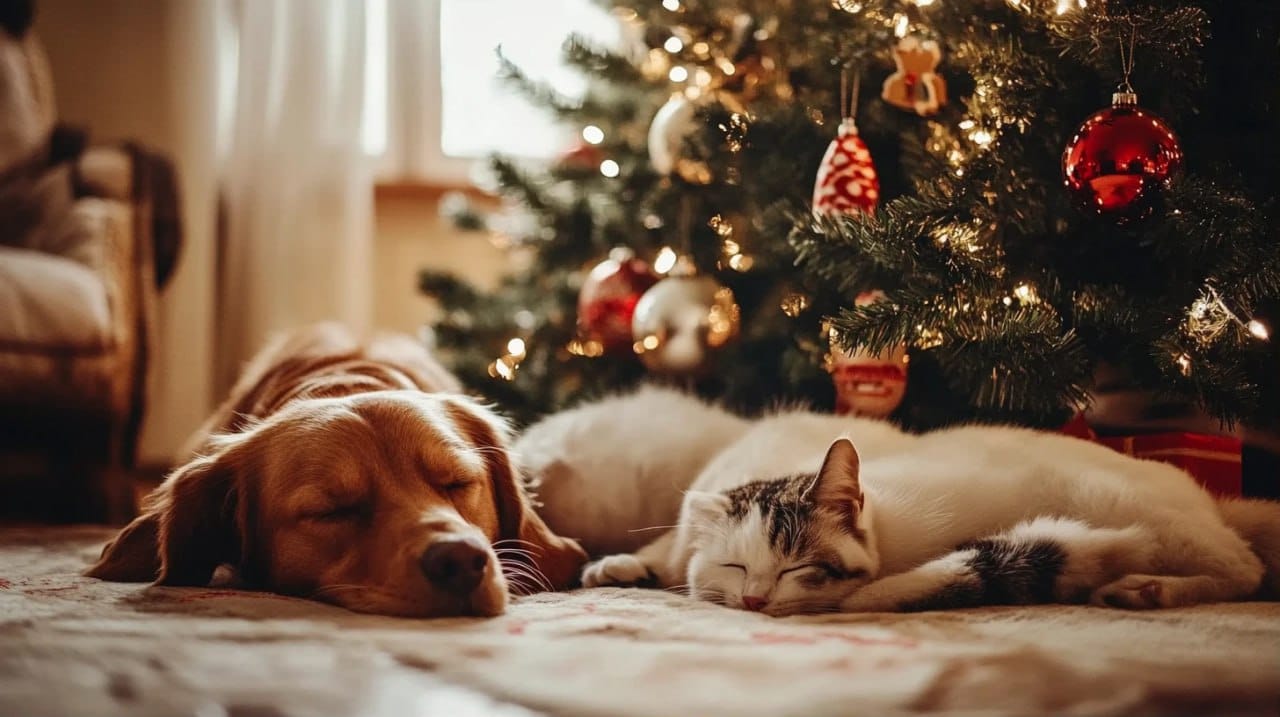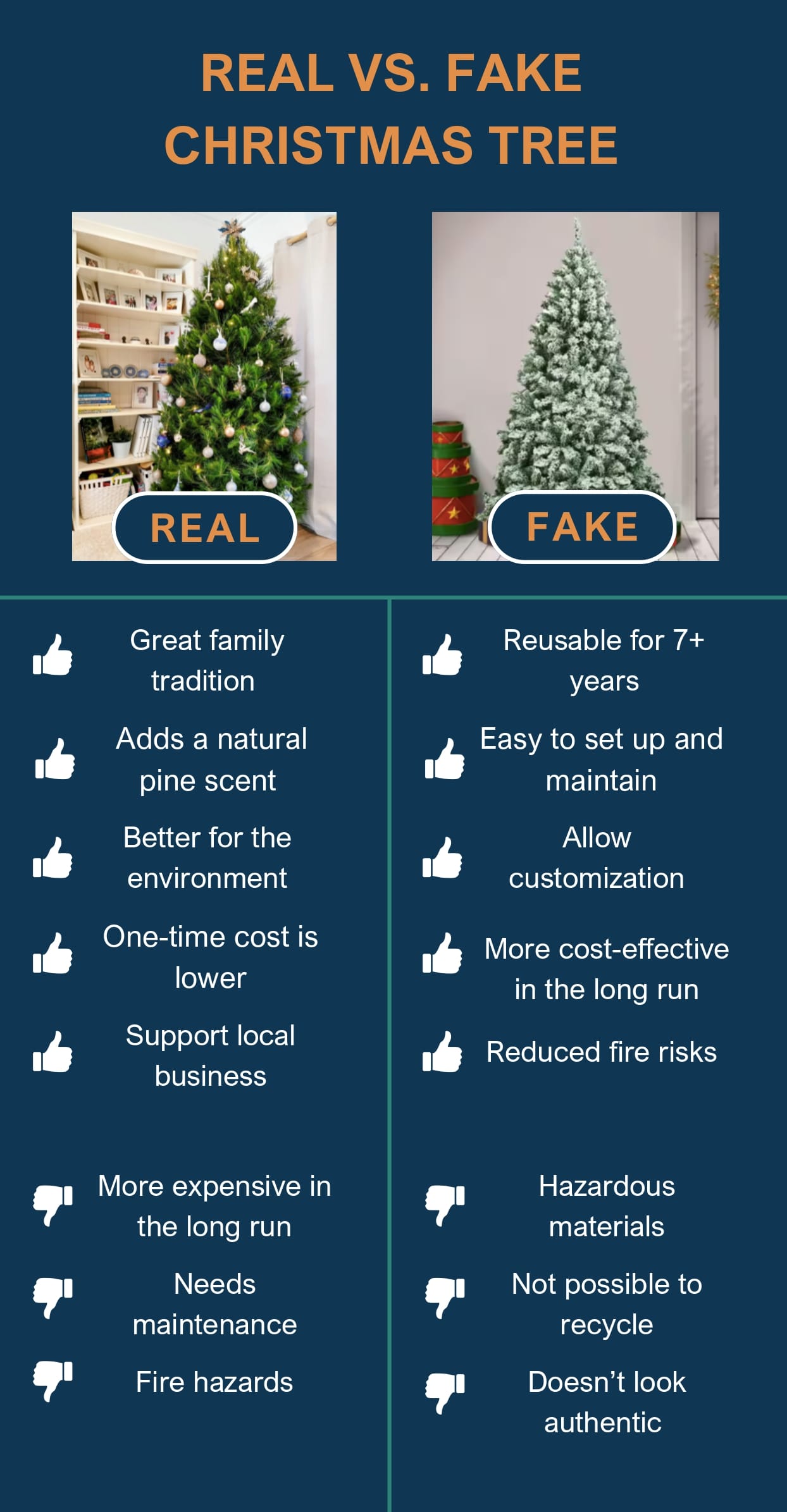Real vs Fake Christmas Tree: Pros, Cons & How to Choose the Best One
The Christmas tree is the central element of the holiday celebration, but it might be challenging to choose between a real and an artificial tree. In this guide, we explain the pros and cons of each type of Christmas tree to help you decide.

There are many considerations when choosing a Christmas tree, including budget, environmental impact, and your preferences. Learn what tree is better for best for you.
Real Christmas tree
For many families, choosing and decorating a real Christmas tree is a tradition that signals the beginning of the holiday season. Natural trees have many advantages, and here are some of them:
Heartwarming family tradition
Getting a real Christmas tree can become a tradition and a fun activity for your family. You can go to a local tree farm with a family and choose a tree together. Little ones will gladly participate in this activity, too. Buying, setting up, and decorating a natural tree is a perfect weekend activity and a bonding experience. It’s not the same as taking an artificial tree from the closet or garage!
Natural scent
Nothing can be compared to a fresh evergreen scent. The smell of fresh pine puts everyone in the holiday mood, creates a relaxed atmosphere, and evokes warm childhood memories. One survey revealed that 85% confirmed real tree scent makes their home feel more festive. You can use a scented candle or essential oils instead, but the effect is not the same.
More environmentally-friendly
Despite the common misconception that fake trees are more eco-friendly, natural trees are actually better for the environment, especially if sourced organically. Here are some quick stats to back this up:
- Nearly 90% of artificial trees are imported from China, increasing carbon emissions.
- One acre of Christmas trees produces oxygen for 18 people every day.
- Real Christmas trees provide a natural habitat for many species and protect the land from development.
Easy to recycle
Real trees are 100% recyclable. Unlike fake trees that remain in the landfill forever, you can make compost for your garden out of it or throw it into the water to use as a reserve for fish. Thus, a natural tree harmlessly biodegrades, which is good for the environment.
Tip: Find more ways to sustainably recycle your Christmas tree here.
Support local businesses
By purchasing a real tree from the farm nearby, you can support a local business. While artificial trees are mostly sold by international retailers, real ones come from local organizations. Your purchase becomes more meaningful, which is especially important before Christmas, and the money stays in your community.
Purchasing a local Christmas tree also helps the economy, as the Christmas tree industry employs 100,000+ people across the US. Plus, after you buy the tree from the local farm, it is quickly replaced by a new one.
Lower price
Real trees, especially local ones, are usually cheaper. If you live on a budget right now, buying a real tree offers a significant economy.
How much is the Christmas tree?
The price for a small Christmas tree can start at $45, whereas higher trees cost $80 and above. An artificial tree will cost you $100 and higher.
Downsides of buying a real Christmas tree
Real Christmas trees have their cons which you need to consider before heading to the farm:
- More expensive in the long run. You need to purchase a new tree every year, and in the long run, it will cost you much more than investing in a fake tree that can last years.
- Need maintenance. A real tree requires your attention every day to stay fresh for a long time. You should water and trim it to keep it neat, and needles dry and fall, which creates a need for frequent cleanup.
- Might not be pet-friendly. Despite their beauty and scent, real trees are not so safe for your pets. They can ingest the fallen needles or drink water from the tree stand that contains chemicals.
- Fire hazards. If located near the fireplace or not maintained properly, real trees become highly flammable.

Fake Christmas tree
Artificial Christmas trees are easier to maintain and store and are more economical in the long run. You can use it for years without the need to buy a new one. Here are some reasons why a fake tree might be a good option for you.
Reusable for many years
Once you’ve invested in a faux Christmas tree, you can use it for years. On average, an artificial tree lasts 7-9 years, which offers a significant economy in the long run. It saves you time and energy, as there’s no need to go and choose a tree every year.
Cheaper than the real one
The one-time cost of the fake tree is bigger. However, as we mentioned before, if you plan to use the tree for years, it saves you lots of money in the long run. Moreover, the price for a real tree increases every year, and with a fake one, you’ll avoid these additional costs.
Easy to set up and maintain
If you’re looking for a quick, low-maintenance tree, a fake one is your best choice. You can take it out of the closet and set up everything in an hour or two.
Plus, it’s incredibly easy to maintain. If you buy a real tree, you need to water it, trim it, and clean up the fallen needles, which can be overwhelming during the holiday season. After you’ve set up a fake tree, you can forget about it until the end of the holidays and it will look excellent without any effort.
Customizable options
There is a variety of shapes and sizes of fake Christmas trees available, so you can pick the exact tree from your dreams, even if this type of pine doesn’t grow in your area. With fake trees, there is no limit to your creativity. You can pick a tree in red or blue color, an oddly shaped or upside-down tree, a tree with artificial snow, or a pre-lit one – your imagination is the limit! If you plan to impress your guest with a creative tree, a fake one is more suitable.
Doesn’t cause allergies
Fake trees usually don’t contain allergens, which is important for highly sensitive people. They are also a great fit if you’re not a fan of the fresh pine scent. You can create the mood using any essential oil that appeals to you or scented candles.
Downsides of buying a fake Christmas tree
There are plenty of disadvantages to artificial trees – here are the main ones:
- May contain hazardous materials. About 80% of trees are imported from China, and not all manufacturers have high production standards. There is a risk that your tree might contain hazardous materials.
- Environmentally unfriendly. The production of artificial trees requires significant energy, and transporting them to the US leaves a high carbon footprint.
- Not disposable. Fake trees are made from non-biodegradable plastic and end up in landfills, while real ones naturally decompose.
Real vs fake Christmas tree infographic
Here are all the pros and cons of each tree to help you make an informed choice:

So, which tree to choose?
A beautifully decorated Christmas tree sets the mood for your holiday party, so take the time to choose one that is best for your budget and suits your preferences. Generally, it is better to get a natural Christmas tree – it is more environmentally friendly, has a wonderful scent, and getting one can become a long-lasting tradition. However, if you prioritize convenience and easy setup, and plan to use the tree for a long time, you might consider a fake tree as well.
Enhance your Christmas celebration with a Secret Santa gift exchange
Christmas is about decorating the tree, preparing a festive dinner, and giving presents to your family, friends, and coworkers. To make your gift exchange process easier and more economical, organize a Secret Santa this year.
With the MySanta app, quickly invite players online, draw names, and plan the reveal party. Moreover, players can share gift ideas and add items to their wishlist to make choosing gifts easier for everyone. Try the game today and make it a wonderful tradition!

FAQs
How long does an artificial Christmas tree last compared to a real one?
When considering artificial vs real tree lifespan, remember that fake trees can last from 7 to 20 years if properly maintained. Such trees are made from durable PVC, so they don't decay or loose needles. In contrast, a real Christmas tree usually lasts between 3 and 4 weeks after cutting depending on how well you maintain it.
Are real Christmas trees more dangerous for pets?
Real Christmas trees can be dangerous for cats and dogs. Brittle needles can cause injuries if ingested or if a pet scratches or chews on them. Moreover, the tree water may contain preservatives which are toxic for pets. Furthermore, the electrical lights and ornaments on a real tree can tempt pets to chew on cords, leading to electrical shocks or choking hazards. To keep Christmas tree safe for pets, supervise them when they are around the tree.
What smells better: a real tree or a scented artificial one?
Many people enjoy a natural piney aroma of a real tree. This scent creates a festive atmosphere and evokes feelings of warmth and holiday cheer. However, which tree smells better depends on personal preference, as some are comfortable with a scent of a high-quality scented artificial tree.



